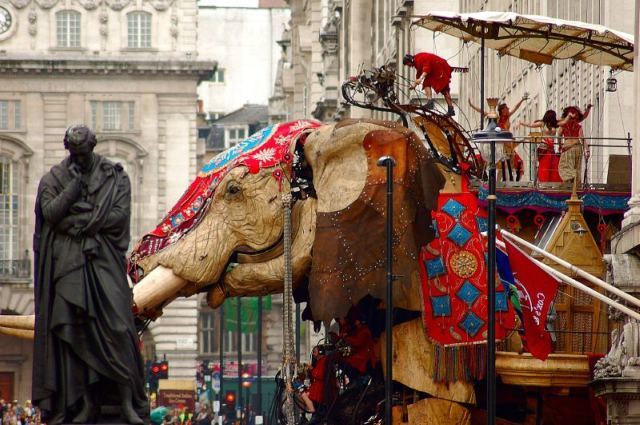With all the attention heaped upon the 250 plastic pachyderms of the current Elephant Parade, we thought we'd give some space to their predecessors. The first recorded elephant in town came over with the Romans around 2000 years ago. Since then, we've seen vicious elephants, robotic elephants, famous elephants and even drunken elephants.
43 AD: Emperor Claudius brings the first recorded elephant to England during the Roman conquest. It journeys to Colchester but would have probably passed through the London area.
1255: Louis IX of France gifts his elephant to Henry III, who subsequently installs it in the Tower menagerie. This is the first known elephant to visit England for 1200 years.
1257: The Tower elephant dies, reportedly from drinking too much red wine.
1622: The Worshipful Company of Cutlers adopts arms showing two elephants plus a smaller elephant with a castle on its back. Ivory was often used in cutlery of the period, hence the elephant connection.
1763: A Captain Samson presented a Bengal elephant to the King at the Queen's House (what was to become Buckingham Palace). The beast was walked through the streets of London from Rotherhithe with 'two blacks and a seaman' on its back. It was kept for some time, taking regular walks in St James Park.
1765: The first recorded mention of the name Elephant and castle. The name is thought to be taken from a local coaching inn, which in turn was named after the arms of the Worshipful Company of Cutlers.
1810: Chunee the Indian elephant is brought to London and exhibited at the Covent Garden Theatre to much awe.
1813: Byron visits Chunee, now housed at the Exeter Exchange menagerie on the Strand. He later wrote in his journal: "The elephant took and gave me my money again — took off my hat — opened a door — trunked a whip — and behaved so well, that I wish he was my butler."
1826: While out for a walk on the Strand, Chunee turns on his keepers, killing one. A few days later, the elephant was executed (with great difficulty) by over 150 musket balls and a sword. His bullet-bitten skeleton was on show at the Hunterian Museum until destruction during WWII.
1831: London Zoo receives its first elephants.
1840: Workers building Trafalgar Square unearth the remains of a woolly mammoth, killed by humans many thousands of years before.
1850: Another set of mammoth tusks is found during construction of King's Cross station. The legend that the battle between Boudicca and the Romans took place at King's Cross may stem from this discovery - the tusks were attributed to Claudius' elephant and were found in the area then known as Battle Bridge.
1865: Jumbo the African elephant transfers from Paris to London Zoo, where he was given the name which has since been synonymous with elephants.
1882: Jumbo is sold to PT Barnum and leaves London.
2001: Zoo worker Jim Robson is crushed to death by an Asian elephant. London Zoo's three elephants were later transferred to Whipsnade, ending a 170-year tradition at the zoo.
2006: The giant, robotic Sultan's Elephant comes to town. Without a doubt, the greatest piece of London street theatre from the last decade, if not longer.
2010: Elephant Parade highlights the plight of the Asian elephant by placing 260 hand-painted plastic elephants around the capital.













